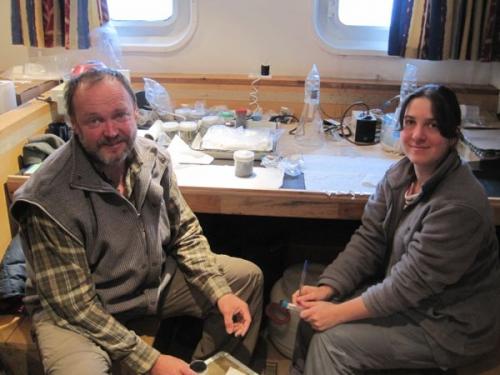Last night's station was tough as we found mostly rocks in our grabs, and it took a very long time to sieve the mud and then sort the rocks to see if there was anything on them to preserve. "Empty" rocks were tossed overboard. We had another station this morning and found lots of mud but, once again, not much living on the bottom. One more station after lunch brought almost everyone on deck, both those who were working and those taking pictures. We're surrounded by glassy blue water dotted with ice flows, and the sun is shining. And, best of all, we spotted a polar bear, and everyone rushed to the bow to check it out. What a change from the conditions of the first week!
Someone who is always on deck just before we are is Alexander Savvichev, a scientist/teacher from the Institute of Microbiology, Russian Academy of Sciences. Alexander describes himself as a teacher of biological ecology with a special interest in the processes of water microorganisms in their natural environmental as opposed to the laboratory. When the Russian geology team brings up their large box core, Alexander is often one of those taking samples of the surface sediments. He explained that there are microorganisms in the surface sediments that oxidize organic compounds from the water column, and his interest is in two particular groups. The first are the methane generators, archae, that require an environment without oxygen and actually live in the sediment particles. The second group is those that oxidize the methane generated by the first group. Methane generated in the sediments can penetrate from the sediments to the water column and, if in high enough concentrations, can pass to the surface. While we often hear of the role of carbon dioxide as a greenhouse gas, methane is a far more active greenhouse gas and, with pollution or an increase in temperature, more methane may be generated and potentially released to the surface. However, bacteria in the water column have a chance to oxidize it. It's this generation/oxidation cycle of methane that Alexander finds so interesting. He'll also take samples from the sediments in the box core where he gets a visual representation (the color of the mud) of the boundary of oxygenated and reduced oxygen conditions. He squeezes out the water and analyzes the DNA of the microbes present to determine the presence of methane oxidizing bacteria. Some of this work will be done at the Nanogene Institute in Seattle Washington.
Alexander and his associate, Elena Zakharova, will also collect surface and bottom water from the CTDA research tool that is submerged in the water to measure conductivity (salinity), temperature, and depth. with three goals in mind. First, they microscopically examine the samples to determine numbers of all bacteria present. (It´s impossible to identify species with this method.) Their next step is to use chemical analysis to evaluate the concentration of methane in the sample. Lastly, he assesses the activity rate of methane oxidizing bacteria to determine if the activity of bacteria in the water column is high or low. It´s not known yet what the variables are that might cause differences in activity level. Could it be water temperature? Perhaps salinity? One of the reasons Alexander is so excited to be a part of the RUSALCA mission is that he feels he can benefit from the joint work of all the science teams on board, using the combined data to possibly provide answers for some of these questions.



Comments